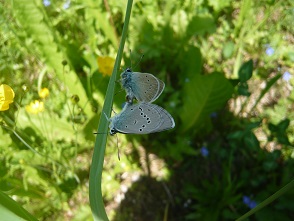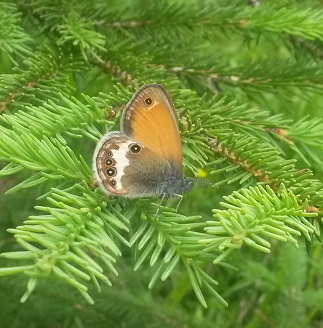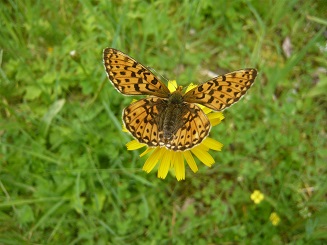Photos with this report (click to enlarge) | |||
 Mazarine Blue |
 Pearly Heath |
 Small Pearl-bordered Fritillary |
|
This was a 10 day holiday with my wife where we made casual observations of various wildlife and flora; no concerted effort was made to either target specific species or maximise lists. The weather was good – mostly sunny with very little rain and daytime temperatures ranging between 15 and 28 degrees Celsius, even at the higher elevations.
ACCOMMODATION AND LOGISTICS
We stayed in a comfortable self-catering apartment in Aparthaus Alpina in the ski resort Pertisau (booked through booking.com and excellent value at Eur57/day). The resort lies at an altitude of just short of 1,000 metres and the two nearby lifts take you up to 1,500m and 1,800m. The only supermarket in the resort was adequate for our daily requirements, enabling a choice of either eating in or out at one of the many restaurants within easy walking distance. We did not hire a car; all visitors are issued with an Achensee card which gives free travel on the local bus network. In addition, we paid Eur69 each for an Achensee holiday card which gives unlimited free access for 7 days to the 2 cable lifts and the boat on the lake (plus museums etc). Tip: the 10am bus from Pertisau to the Rofan lift in Maurach gets very full – we suggest you get on the bus at the start point at the Karwendel lift.
THE AREA
From our Pertisau base, our 3 main areas of natural history focus were:
• The Tristenau valley
• The meadows accessed from the top of the Karwendel lift and the area around the Barenkopf
• The higher montane pastures and woods accessed from the top of the Rofan lift
In addition, the footpath running alongside the western shore of Achensee is also worth exploring.
BIRDS
Black Redstarts were common around the resort. Ring Ouzels were seen around the top of the Rofan lift and at least one pair were collecting food for young. Alpine Choughs were confiding around the mountain cafes and restaurants and also seen at distance around the high cliffs. We saw very few raptors with just one Golden Eagle observed flying around the top of the Streichkopf. Black Woodpecker was heard and seen well in the Tristenau valley. Willows Tits were heard calling several times and seen on a couple of occasions, often with Serin nearby, in several locations.
LEPIDOPTERA
There is much to offer the butterfly and moth enthusiast here at this time of year. Our highlights were seeing a male Alpine Blue on the slopes just SE of the Dalfazalm restaurant, Large Blues near the top of the Karwendel lift and two colonies of Silver-studded Blues together with many Chequered Skippers in the Tristenau valley. Day flying moths were numerous. We were not familiar with the rather dull subspecies of Marsh Fritillary found in these parts and it had us puzzled for a little while as a ‘not quite right’ Marsh Fritillary. A Thor’s Fritillary on our final day was a first for us.
We have only recorded those species we were able to identify with reasonable confidence – several were netted and released to check (Small Pearl-bordered Fritillary, Small Argent and Sable, Silver-studded Blue etc). There were many we could not identify (particularly the fast flying Skippers) with any degree of certainty; for every single butterfly or moth positively identified, there must have been at least five which evaded us. Given the casual nature of our observations and the fact that we saw new species each day even in areas previously visited suggested that we were only scratching the surface. We encountered a large number of day flying moths in each visit to the mixed woodland in the Tristenau valley which made us ponder what wonderful gems a portable light trap left overnight might yield.
FLORA
Again, the area has a wealth of alpine flora to admire and enjoy. We are not ‘botanists’ by any means but managed to identify a wide variety of flowers with the help of our favourite ID books together with ‘Mountain Flowers -The Dolomites' by Cliff Booker and David Charlton (ISBN 978-0957162808).
BUTTERFLIES
Large Skipper (Ochlodes sylvanus)
Chequered Skipper (Carterocephalus palaemon)
Dingy Skipper (Erynnis tages)
Grizzled Skipper (Pyrgus malvae)
Orange-tip (Anthocharis cardamines)
Mountain Green-veined White (Pieris bryoniae)
Black-veined White (Aporia crataegi)
Wood White (Leptidea sinapsis)
Green Hairstreak (Callophrys rubi)
Small Pearl-bordered Fritillary (Boloria selene)
Thor’s Fritillary (Boloria thore)
Heath Fritillary (Mellicta athalia)
Marsh Fritillary (Euphydryas aurinia ssp debilis)
Small (Little) Blue (Cupido minimus)
Large Blue (Maculinea arion)
Mazarine Blue (Cyaniris semiargus)
Alpine Blue (Albulina orbitulus)
Silver-studded Blue (Plebejus argus)
Red Admiral (Vanessa atalanta)
Small Tortoiseshell (Aglais urticae)
Speckled Wood (Pararge aegeria)
Large Wall Brown (Lasiommata maera)
Pearly Heath (Coenonympha arcania)
MOTHS
White-spotted Sable (Anania funebris)
Speckled Yellow (Pseudopanthera macularia)
Burnet Companion (Euclidia glyphica)
Purple & Gold (Pyrausta purpuralis)
Wavy-barred Sable (Pyrausta nigrata)
Straw-barred Pearl (Pyrausta despicata)
Small Purple-barred (Phytometra viridaria)
Small Argent & Sable (Epirrhoe tristata)
Common Heath (Ematurga atomaria)
Latticed Heath (Chiasmia clathrata)
Mother Shipton (Euclidia mi)
Hummingbird Hawk-moth (Macroglossum stellatarum)
Narrow-bordered Bee Hawk-moth (Hemaris tityus)
Cinnabar (Tyria jacobaeae)
Ruby Tiger (Phragmatobia fuliginosa)